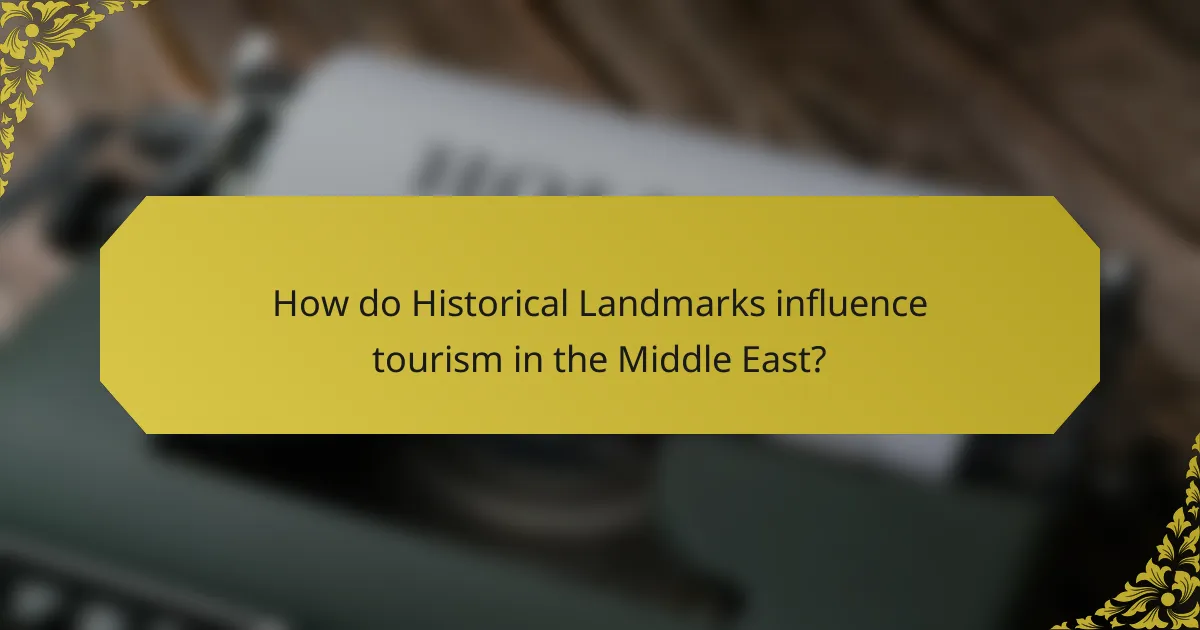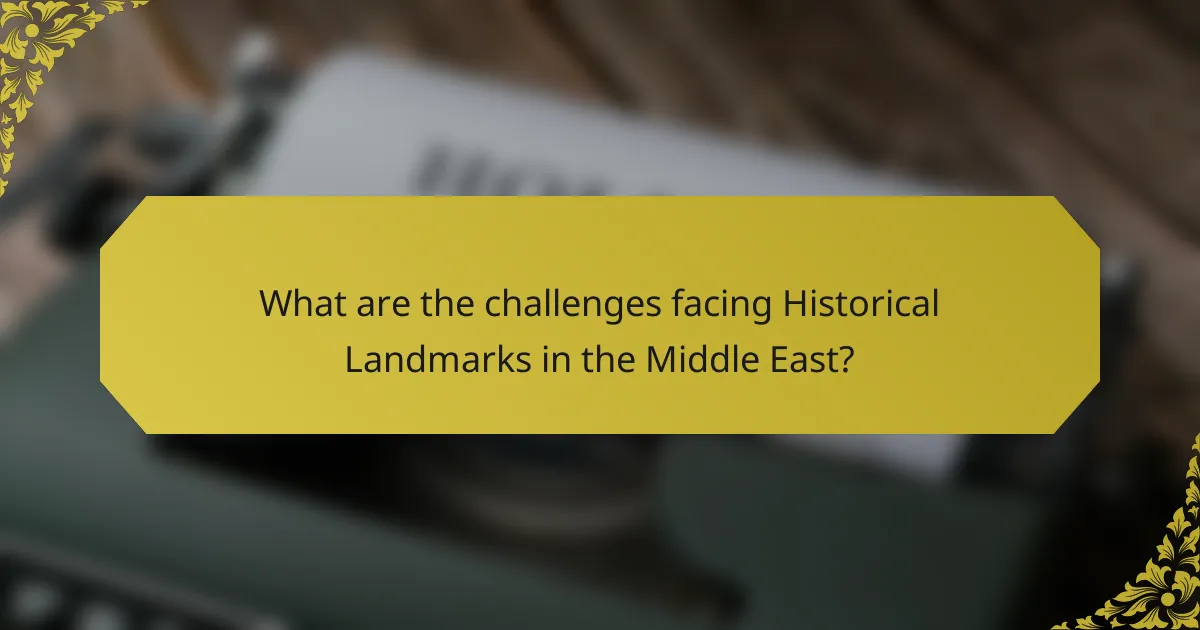
What are Historical Landmarks in Middle Eastern Culture?
Historical landmarks in Middle Eastern culture include sites such as the Pyramids of Giza, Petra, and the Dome of the Rock. The Pyramids of Giza, built around 2580–2560 BC, are iconic tombs of ancient Egyptian pharaohs. Petra, a UNESCO World Heritage site, showcases rock-cut architecture and water conduit systems from the Nabataean civilization. The Dome of the Rock, completed in 691 AD, is an important Islamic shrine located in Jerusalem. These landmarks reflect the region’s rich history and diverse cultural heritage. They serve as symbols of architectural innovation and religious significance throughout centuries.
How do Historical Landmarks reflect the cultural heritage of the Middle East?
Historical landmarks in the Middle East reflect the region’s cultural heritage through their architectural styles, historical significance, and symbolic meanings. These structures, such as the Pyramids of Giza and Petra, showcase ancient engineering and artistry. They represent the diverse civilizations that have inhabited the region, including the Egyptians, Persians, and Ottomans. Each landmark tells a story of cultural practices, religious beliefs, and social structures from different historical periods. For instance, the Alhambra in Spain illustrates Islamic art and architecture’s influence during the Moorish period. Additionally, these sites attract millions of visitors, emphasizing their importance in preserving and promoting cultural identity. The UNESCO World Heritage designation of many landmarks highlights their global significance and the need for their protection.
What are the defining characteristics of these landmarks?
Historical landmarks in the Middle East are characterized by their architectural styles, historical significance, and cultural relevance. These landmarks often exhibit intricate designs that reflect the artistic traditions of the region. Many structures, such as mosques and palaces, showcase unique elements like domes, minarets, and ornate tile work.
Additionally, these sites often serve as symbols of cultural identity and heritage for local communities. For example, the Great Mosque of Samarra is notable for its spiral minaret, which is a distinctive architectural feature. Furthermore, historical landmarks frequently represent significant events or figures in the region’s history, such as the Pyramids of Giza, which are linked to ancient Egyptian civilization.
Many of these sites are recognized by UNESCO as World Heritage Sites, emphasizing their global importance. The preservation of these landmarks is crucial for maintaining cultural continuity and educating future generations. Overall, the defining characteristics of Middle Eastern landmarks encompass their architectural uniqueness, historical context, and cultural significance.
How have these landmarks evolved over time?
Historical landmarks in the Middle East have evolved significantly over time. Many landmarks, such as the Great Pyramids of Giza, have undergone restoration and preservation efforts to maintain their structural integrity. The ancient city of Petra has seen changes in accessibility with improved tourism infrastructure. Architectural styles have also transformed, reflecting various cultural influences throughout history. For example, Islamic architecture has integrated elements from Byzantine and Persian styles. Urban development has altered the surrounding landscapes, often leading to the juxtaposition of modern structures with ancient sites. Additionally, conflicts in the region have resulted in damage and reconstruction of several landmarks. The evolution of these landmarks reflects the dynamic history and cultural shifts within the Middle Eastern region.
Why are Historical Landmarks significant to Middle Eastern identity?
Historical landmarks are significant to Middle Eastern identity because they embody the region’s rich cultural heritage. These sites reflect the diverse histories and civilizations that have shaped the Middle East, including ancient empires, religious traditions, and architectural innovations. For instance, landmarks like the Pyramids of Giza and Petra serve as symbols of national pride and historical continuity. They attract millions of visitors, reinforcing a sense of belonging among local populations. Furthermore, these landmarks are often central to community rituals and celebrations, strengthening cultural ties. The preservation of such sites is crucial for maintaining historical narratives and fostering a collective identity.
What role do these landmarks play in community and national pride?
Landmarks serve as symbols of community and national pride. They embody historical significance and cultural identity. For instance, the Pyramids of Giza represent ancient Egyptian civilization. Such landmarks often attract tourism, boosting local economies. Additionally, they foster a sense of belonging among residents. Communities rally around these sites for celebrations and events. National pride is reinforced through recognition of shared heritage. In many cases, these landmarks are protected as national treasures. This protection underscores their importance to collective memory and identity.
How do they contribute to the region’s cultural narratives?
Historical landmarks contribute to the region’s cultural narratives by serving as symbols of heritage and identity. They embody historical events, architectural styles, and artistic expressions unique to the Middle East. For instance, the Great Pyramids of Giza represent ancient Egyptian civilization and its achievements. Similarly, the Alhambra reflects the Islamic Golden Age and showcases intricate Moorish architecture. These landmarks foster a sense of belonging among local communities. They also attract tourism, which helps to preserve and promote cultural traditions. Furthermore, they inspire local art, literature, and folklore, enriching the region’s cultural landscape.
What types of Historical Landmarks exist in the Middle East?
The Middle East is home to various types of historical landmarks. These include ancient ruins, religious sites, and architectural marvels. Prominent ancient ruins are found in places like Petra, Jordan, and Palmyra, Syria. Religious sites include the Dome of the Rock in Jerusalem and the Great Mosque of Samarra in Iraq. Architectural marvels encompass structures like the Alhambra in Spain and the Citadel of Aleppo in Syria. Each landmark reflects the rich cultural and historical heritage of the region. The significance of these landmarks is highlighted by their recognition as UNESCO World Heritage Sites.
What are the most famous religious landmarks?
The most famous religious landmarks include the Kaaba, the Western Wall, and the Dome of the Rock. The Kaaba, located in Mecca, Saudi Arabia, is the holiest site in [censured]. It is the focal point of the Hajj pilgrimage and is a cube-shaped structure. The Western Wall, situated in Jerusalem, is a sacred site for Jews. It is the last remaining wall of the Second Temple, destroyed in 70 CE. The Dome of the Rock, also in Jerusalem, is an iconic Islamic shrine. It is built on the Temple Mount and holds great significance in both Judaism and [censured]. Each of these landmarks is visited by millions of pilgrims and tourists annually, reflecting their deep religious importance.
Which ancient ruins are considered vital to understanding Middle Eastern history?
The ancient ruins vital to understanding Middle Eastern history include the Pyramids of Giza, Petra, and Babylon. The Pyramids of Giza, built around 2580–2560 BC, showcase the architectural prowess of ancient Egypt. Petra, established in the 5th century BC, served as a major trading hub and reflects Nabataean ingenuity. Babylon, known for its Hanging Gardens and the Ishtar Gate, was a center of culture and power in ancient Mesopotamia. These sites provide crucial insights into the civilizations that shaped the region’s history and culture. Each ruin offers artifacts and structures that reveal social, political, and economic aspects of their respective societies.

How do Historical Landmarks influence tourism in the Middle East?
Historical landmarks significantly influence tourism in the Middle East. These sites attract millions of visitors each year. Iconic landmarks like the Pyramids of Giza and Petra are key attractions. They offer unique insights into ancient civilizations. Tourists seek cultural experiences tied to these historical sites. The presence of these landmarks boosts local economies. According to the World Tourism Organization, cultural tourism accounts for 40% of global tourism. In the Middle East, this percentage is even higher due to rich historical heritage. Consequently, preservation efforts for these landmarks are often prioritized.
What impact do these landmarks have on the local economy?
Historical landmarks positively impact the local economy by attracting tourism and generating revenue. Increased visitor numbers lead to higher spending in local businesses. Restaurants, hotels, and shops benefit from the influx of tourists. Additionally, landmarks create job opportunities in the hospitality and service sectors. According to a study by the World Tourism Organization, cultural tourism accounts for approximately 40% of global tourism revenue. This statistic highlights the economic significance of historical sites. Local governments often invest in infrastructure improvements around these landmarks, further stimulating economic growth. Overall, the presence of historical landmarks enhances community development and economic vitality.
How do historical sites attract international visitors?
Historical sites attract international visitors through their cultural significance and unique heritage. These sites often showcase ancient architecture, artifacts, and traditions that resonate globally. The historical value of these landmarks draws tourists seeking authentic experiences. For example, the Pyramids of Giza attract millions annually due to their historical importance and architectural marvel. Additionally, UNESCO World Heritage status enhances visibility and credibility, further increasing tourist interest. Marketing campaigns and travel packages often highlight these features to reach international audiences. Events and festivals at these sites also engage visitors, providing immersive cultural experiences.
What challenges do these landmarks face in terms of preservation and tourism?
Historical landmarks in the Middle East face significant challenges in preservation and tourism. Environmental factors, such as erosion and climate change, threaten their structural integrity. Increased tourism can lead to wear and tear, compromising their preservation. Limited funding for maintenance and restoration projects exacerbates these issues. Additionally, political instability in the region can hinder preservation efforts. In some cases, local communities may not prioritize tourism, affecting economic support for landmarks. UNESCO reports that many sites are at risk due to these combined pressures.
How do cultural practices surround Historical Landmarks enhance their significance?
Cultural practices surrounding historical landmarks enhance their significance by fostering community identity and continuity. These practices often include rituals, festivals, and storytelling that connect people to their heritage. For example, annual celebrations at landmarks can attract visitors and strengthen local traditions. Engaging in these customs promotes a sense of belonging among community members. Furthermore, such practices can draw attention to the historical importance of the site. They often highlight unique architectural features and historical events associated with the landmark. This increased awareness can lead to preservation efforts and tourism development. Ultimately, cultural practices create a living narrative that enriches the landmark’s meaning within the community.
What festivals or events are commonly held at these landmarks?
It is not possible to provide a definitive answer to the question regarding specific festivals or events commonly held at historical landmarks in Middle Eastern culture. The diversity of landmarks and their associated cultural practices varies significantly across different regions and communities. Each landmark may host unique events, often influenced by local traditions, religious practices, and historical significance. Therefore, a generalized answer cannot be accurately formulated without specific landmarks being referenced.
How do local traditions influence the perception of these sites?
Local traditions significantly influence the perception of historical landmarks in the Middle East. These traditions shape the cultural narratives surrounding the sites. For instance, rituals and festivals held at these landmarks create a sense of community and belonging. Local stories and legends often enhance the historical significance of these sites. Additionally, the preservation of traditional practices fosters respect and reverence for the landmarks. This connection can lead to increased tourism and local pride. Research indicates that cultural heritage is vital for identity in the region. Thus, local traditions play a crucial role in how these historical landmarks are viewed and valued.

What are the challenges facing Historical Landmarks in the Middle East?
Historical landmarks in the Middle East face numerous challenges. These include ongoing conflict and political instability, which threaten preservation efforts. Natural disasters, such as earthquakes and floods, also pose risks to these sites. Urban development often encroaches on historical areas, leading to destruction or alteration. Additionally, inadequate funding for maintenance and restoration exacerbates deterioration. Cultural neglect and the lack of awareness can further compromise these landmarks. Lastly, tourism pressures can result in wear and tear, impacting their integrity. Each of these factors contributes to the ongoing struggle to protect and preserve historical landmarks in the region.
How does conflict affect the preservation of these landmarks?
Conflict significantly hinders the preservation of historical landmarks. Armed conflicts often lead to physical destruction of structures. For example, during the Syrian Civil War, UNESCO reported extensive damage to ancient sites like Palmyra. Conflict zones may also experience neglect due to security concerns. Preservation efforts become difficult when resources are redirected to immediate humanitarian needs. Additionally, looting often occurs in unstable regions, further endangering cultural heritage. Historical landmarks can also become targets for military operations, resulting in intentional destruction. Overall, conflict disrupts preservation through destruction, neglect, and looting.
What measures are being taken to protect endangered sites?
Governments and organizations are implementing various measures to protect endangered sites. These measures include legal protections through national and international laws. UNESCO World Heritage designation provides additional support and funding for preservation efforts. Local communities are often engaged in conservation initiatives to raise awareness. Restoration projects are underway to repair and maintain these sites. Monitoring programs track the condition of endangered landmarks. Partnerships between governments and NGOs enhance resource allocation for protection. Education and outreach programs aim to foster appreciation and stewardship among the public.
How does climate change impact these historical structures?
Climate change negatively impacts historical structures through increased weathering and erosion. Rising temperatures can lead to the expansion and contraction of materials. This process causes cracks and structural weaknesses. Increased rainfall and flooding can erode foundations and damage masonry. Additionally, extreme weather events can lead to direct physical damage. For instance, storms may displace stones or topple structures. Changes in humidity levels can also affect wood and other organic materials. Historical landmarks are particularly vulnerable due to their age and the materials used in their construction. Preservation efforts are crucial to mitigate these impacts.
What can be done to promote the preservation of Historical Landmarks?
Promoting the preservation of historical landmarks can be achieved through community engagement and education. Local communities should be involved in preservation efforts. This can include organizing workshops and events to raise awareness. Education programs can inform the public about the cultural significance of these landmarks. Government support is crucial for funding preservation projects. Policies should be enacted to protect historical sites from development. Collaborations with non-profit organizations can also provide resources and expertise. Successful examples include the UNESCO World Heritage program, which recognizes and supports sites globally. These efforts ensure that historical landmarks are maintained for future generations.
What role do local communities play in safeguarding their heritage?
Local communities play a crucial role in safeguarding their heritage. They actively participate in preserving historical landmarks and cultural practices. Community members often engage in restoration projects to maintain the physical integrity of sites. They also educate younger generations about their cultural significance. This transfer of knowledge fosters a sense of identity and belonging. Local traditions and customs are upheld through community events and celebrations. Furthermore, communities advocate for policies that protect their heritage from development threats. Their involvement ensures that cultural narratives remain vibrant and relevant over time.
How can international cooperation aid in the protection of these sites?
International cooperation can significantly aid in the protection of historical landmarks. Collaborative efforts can enhance resource allocation for preservation projects. Countries can share expertise in restoration techniques and conservation practices. Joint funding initiatives can provide necessary financial support for large-scale preservation efforts.
Additionally, international treaties, such as the UNESCO World Heritage Convention, promote the safeguarding of cultural heritage. These treaties establish guidelines for member states to follow in protecting significant sites. Furthermore, global awareness campaigns can mobilize public support for preservation initiatives.
Data shows that sites with international cooperation often receive better protection and funding. For example, the restoration of the ancient city of Petra in Jordan involved multiple countries working together. Such collaborative approaches can lead to more effective and sustainable preservation outcomes.
What are best practices for visiting Historical Landmarks in the Middle East?
To visit historical landmarks in the Middle East effectively, travelers should plan ahead. Research the specific landmark’s history and significance before visiting. Dress modestly to respect local customs and traditions. Always seek permission before taking photographs, especially in religious sites. Engage with local guides for deeper insights and context. Be mindful of cultural sensitivities and follow site rules. Stay hydrated and protect yourself from the sun, as many sites are outdoors. Lastly, consider visiting during off-peak hours to avoid crowds and enhance your experience.
Historical landmarks in Middle Eastern culture, such as the Pyramids of Giza, Petra, and the Dome of the Rock, serve as vital representations of the region’s rich history and diverse cultural heritage. These sites embody architectural innovation and religious significance, reflecting the artistic traditions and historical narratives of various civilizations. The article explores the defining characteristics of these landmarks, their evolution over time, their role in shaping cultural identity, and the challenges they face in preservation and tourism. Additionally, it highlights the economic impact of these sites and the importance of local communities in safeguarding their heritage.


